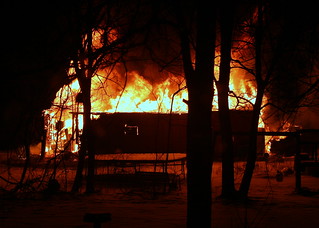Stable Safety – Plan Ahead in Case of Fire
Emergency Planning
Are you ready for an emergency? It is not very nice to think about, but do you have a plan in place? If you own your own stable or board your horse, having a plan is the safest bet in case of emergency.
What to do in case of emergency

EMERGENCY! the words just makes my stomach turn.
- Have emergency information and plan of action posted in prominent locations.
Have the Civic address, and directions easily accessible. This information is necessary when calling the police, ambulance and fire. Having the information readily available avoids panicked callers fumbling for information. - Have contact information easily labeled and handy. This includes numbers for the stable manager, horse owners/leasers, veterinarian, and ‘other’ emergency contact people should necessary to contact.
- Have the property address and name prominently displayed from the roadside. This will give emergency personnel ideal information to locating your farm when necessary.
-
The following is a list of essential items a horse owner should keep in or near their home and possibly in another location off the property as well.
- First aid kit – Human and horse
Contact information for horses including photos and written descriptions of all horses – this is important in case of insurance.
Halters and lead ropes
Flash lights and extra ‘charged’ batteries
Have a Plan

Although it is tough to think about having an evacuation plan is the best course of action. An evacuation plan should be designed to remove horses safely and quickly from the stable without anyone getting hurt.
It is important stable managers, workers, boarders, leasers and other people involved at the stable understand the importance of the evacuation plan and are involved with its implementation. Having everyone understand ensures the plan is followed even if the manager or owner is not present at the time of the emergency.
Having horse owners involved makes them aware emergencies happen and makes them think about how they will work through any unforeseen emergencies. Consider the following when developing your plan:
- How will horses be removed from the stable? Will each horse be lead individually or will the horses be herded outside into a holding pen?
- How will stallions, mares and foals, young horses be handled vs school horses, boarders and show horses?
- What’s the plan if the barn burns down? Where will horses be housed? This is of particular importance if it is winter and there are significant weather challenges.
Horse Identification
If you are a horse owner make a complete binder of your horse with pertinent information which will be helpful in emergency situations. If you horse is registered, tatooed or has a microchip, collect this information into one area and keep it safe. Also consider taking photographs and written descriptions.
 Try these three powerful exercises to get strengthen your position.
Try these three powerful exercises to get strengthen your position.
